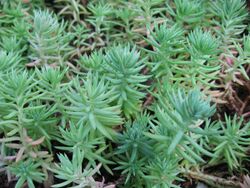Biology:Petrosedum rupestre
| Petrosedum rupestre | |
|---|---|

| |
| Scientific classification | |
| Kingdom: | Plantae |
| Clade: | Tracheophytes |
| Clade: | Angiosperms |
| Clade: | Eudicots |
| Order: | Saxifragales |
| Family: | Crassulaceae |
| Genus: | Petrosedum |
| Species: | P. rupestre
|
| Binomial name | |
| Petrosedum rupestre (L.) P.V.Heath
| |
| Synonyms | |
|
List
| |
Petrosedum rupestre, also known as reflexed stonecrop,[1] Jenny's stonecrop,[2] blue stonecrop, stone orpine, prick-madam and trip-madam,[3] is a species of perennial succulent flowering plant in the family Crassulaceae, native to northern, central, and southern Europe.
Description
Petrosedum rupestre plants are typically up to 10 cm high, with sprawling stems and stiff foliage resembling spruce branches, with softer tissue. The leaves are frequently blue-gray to gray but range to light greens and yellows; the flowers are yellow. Like many Sedum species, it has a prostrate, spreading habit.
Cultivation
Petrosedum rupestre is a popular ornamental plant, grown in gardens, containers, and as houseplants. It is drought-tolerant. There are named cultivars with variegated (multi-colored) leaves. Through vegetative cloning it is propagated from cuttings.[4]
This sedum is prone to fasciation (cristate forms), which produces attractive cactus-like forms, with irregular curves. However it reverts easily, so all normal offshoots need to be removed quickly to maintain the cristate form.[5]
Petrosedum rupestre is occasionally used as a salad leaf or herb in Europe, including the United Kingdom.[6] It is said to have a slightly astringent or sour taste.
References
- ↑ (xls) BSBI List 2007, Botanical Society of Britain and Ireland, https://bsbi.org/download/3542/, retrieved 2014-10-17
- ↑ "Sedum reflexum". Natural Resources Conservation Service PLANTS Database. USDA. https://plants.usda.gov/core/profile?symbol=SERE4.
- ↑ trip-madam (3rd ed.), Oxford University Press, September 2005, http://oed.com/search?searchType=dictionary&q=trip-madam (Subscription or UK public library membership required.)
- ↑ Horvath, Brent. "The Plant Lover's Guide to Sedums".Timber Press Inc., 2014, p. 113
- ↑ Stephenson, Ray (1994). Sedum. Timber Press. ISBN 0-88192-238-2. https://books.google.com/books?id=Jo9VgQAsMtkC&pg=PA123.
- ↑ "Sedum rupestre - L. Crooked Yellow Stonecrop". Plants for a Future. http://www.pfaf.org/database/plants.php?Sedum+rupestre.
- Sedum rupestre ‘Angelina’
- Cristate forms in Crassulaceae family, Peter Lapshin
External links
Wikidata ☰ {{{from}}} entry
 |

